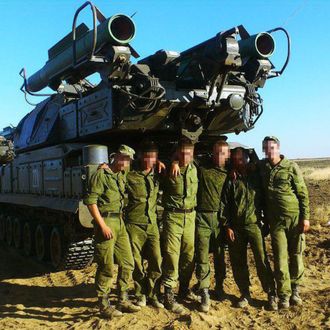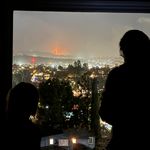
On June 23, 2014, the 2nd Battalion of the 53rd Anti-Aircraft Missile Brigade left its base outside Kursk, Russia, driving south to the village of Millerovo, near the Ukraine border. Commanded by Lieutenant Dmitry Yuryevich Trunin, the battalion was equipped with a Buk medium-range surface-to-air missile system, including six missile launchers, three missile loaders, a command vehicle, and a Buk Snow Drift radar vehicle. Reaching Millerovo on June 25, the battalion encamped within five miles of an area of Ukraine controlled by separatists, and settled in. Three weeks later, on the night of July 16, one of the Buk launchers was hauled across the border and taken down the M4 highway to the rebel-held city of Donetsk. The next morning, it was brought to the village of Snizhne, then to an open field almost directly underneath a busy commercial aviation airway, L980. At 4:20 p.m. local time, flight MH17, a Malaysia Airlines 777, en route from Amsterdam to Kuala Lumpur, approached from the northwest at an altitude of 33,000 feet. The Buk fired a single 9N314M rocket, whose 150-pound shrapnel-laden warhead exploded within feet of the cockpit. The passengers and crew of MH17 were scattered over the fields near the village of Hrabove. The Buk was taken back across the border into Russia the next day.
This, at least, is the story that emerges in a 114-page report released Wednesday by the public-source intelligence analysts Bellingcat. Titled “MH17: Potential Suspects and Witnesses From the 53rd Anti-Aircraft Missile Brigade,” it builds on a series of earlier Bellingcat reports.
Pieced together from Russian social-media postings by the soldiers and officers and their wives, today’s report paints a detailed picture, complete with names, pictures, and license-plate numbers, of a military mission that culminated in the deadliest shootdown of a civilian airliner in history. “Ultimately,” Bellingcat wrote in an email to journalists that accompanied the report, “responsibility for the downing of MH17 from a weapon provided and possibly operated by the Russian military lies with the Ministry of Defense and the Supreme Commander of the Russian Armed Forces, President Vladimir Putin.”
This is not the first international controversy provoked by Bellingcat’s founder, Eliot Higgins. The U.K. blogger first attracted attention after using social media to locate evidence that the Syrian regime had used chemical weapons, a finding that provoked a showdown between Assad and Obama. He then formed Bellingcat as an informal network of amateur investigators who use satellite images, tweets, status updates, and other forms of “open-source intelligence” to produce freely available analysis on a wide range of pressing topics. Highly regarded for its reliability and transparency, the group’s work has been praised by the Columbia Journalism Review as “rigorous, evidence-based examinations of extremely specific questions” that are “extremely valuable in helping us understand complex subjects.”
The sequence of events depicted by Bellingcat — in which MH17 was shot down by a regular Russian army unit — runs counter to the accepted narrative, which holds that the missile was accidentally launched by ill-trained militiamen who had gotten their hands on an extremely powerful and dangerous piece of weaponry and didn’t understand how to use it. This narrative has ample foundation. In the immediate aftermath of the attack, separatist leader Igor Strelkov gloated over social media that the rebels had managed to shoot down an Antonov 26 transport, then took down the posting once it became clear that the plane was actually a passenger airliner. Likewise, Ukrainian intelligence intercepted cell-phone calls by militia members exhibiting shock after recognizing the nature of the act. It has since then been almost universally accepted among journalists and analysts that, as Aviation Week’s Bill Sweetman put it, “Malaysia Airlines Flight MH17 was shot down by Ukrainian separatist rebels who believed they were engaging a military aircraft.”
The Bellingcat report doesn’t specify who pushed the “fire” button. But given that the machine in question was delivered from Russia the night before, and went back to Russia immediately afterward, the group discounts the idea that its presence under MH17’s flight path was an unlucky mishap. “When the order was given to send over surface-to-air missiles to shoot down aircraft, this was all part of something that was begun with Vladimir Putin deciding to send Russian troops and Russian equipment into eastern Ukraine,” says Higgins. “Eventually they sent over a Buk missile launcher that shot down a commercial airliner, and 298 people died.”
In the course of its investigation, Bellingcat contributors delved widely and deeply into Russian social-media sources, such as VKontakte and Odnoklassniki, as well as the likes of Instagram and Google Earth. “This report represents over a year of investigative work,” says Higgins. “It shocks me just how much information these soldiers put out there, and how we can piece it all together. When you talk about the Russian military, you just think about this huge nebulous military machine, but we’re saying it’s possible to identify the specific individuals and the specific units who took this missile launcher to the border. It didn’t find its way there by itself.”
Bellingcat’s painstaking research notwithstanding, the idea that Putin would order MH17 shot down is hard for some to swallow. The consequences were severe for Russia, especially after Europe and the United States imposed sanctions that helped put the Russian economy into a severe recession that continues today. Given the lack of obvious benefit, some observers are skeptical that the Kremlin deliberately ordered the mass murder. “I have seen nothing to suggest the Kremlin ordered or wanted MH17 shot down,” Mark Galeotti, an NYU professor of global affairs who specializes in the Russian security apparatus, told me via email. (Galeotti had not yet read the report; I apprised him of its contents.)
Last year, Dutch civil-aviation investigators officially concluded that MH17 had been shot down by a Buk missile fired from Snizhne, but they pointedly did not affix blame. Responsibility for doing so lies with another group called the Joint Investigation Team, whose members come from the Netherlands, Belgium, Australia, Ukraine, and Malaysia. Bellingcat has already sent the JIT a version of its report, including identifying information and photographs redacted from the public release, but the JIT isn’t saying when or if its final determination will be made. The group was originally scheduled to deliver its findings this year, but last week issued a press release announcing that “it is not possible to say when in the future the JIT will be able to establish what [possible perpetrators’] exact connection to the crime is, their identity, and actual place of residence.”






























